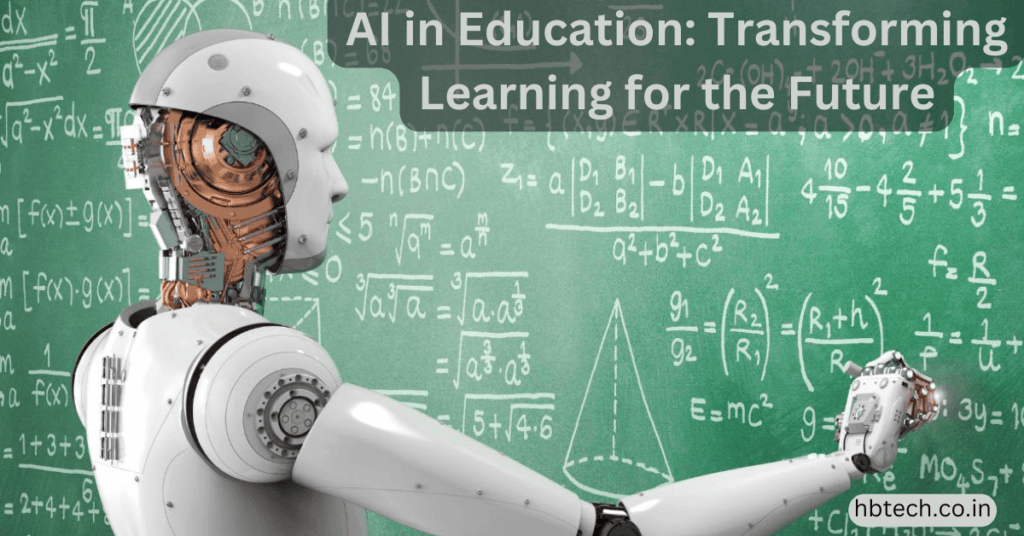Artificial Intelligence (AI) is bringing big changes to education, making learning more personalized, accessible , and efficient. From helping teachers with routine tasks to providing students with customized support, AI is improving how we teach and learn. Let ’s dive into how AI is shaping the future of education in simple terms.
Personalized Learning for Everyone
Not all students learn the same way or at the same speed. AI tools can help by tailoring lessons to each student ’s needs. For example, AI programs can figure out what a student struggles with and provide extra practice or resources to help them catch up
Apps like Duolingo are great examples of this. They adjust language lessons based on how well a learner is doing. In classrooms, AI can suggest extra materials or activities to help students master tricky topics, making learning more effective and enjoyable.
Virtual Tutors to Help Anytime
AI-powered virtual tutors are like having a teacher available 24/7. These tools can answer questions, explain concepts , and guide students through problems whenever they need help.
For instance , if a student is stuck on a math problem, an AI tutor can walk them through the solution step by step. This kind of support ensures students get help outside regular class hours, filling gaps in their understanding.
Reducing Teachers’ Workload
Teachers spend a lot of time on tasks like grading papers, taking attendance, and preparing reports. AI can take over these jobs, freeing up teachers to focus on teaching and connecting with their students,
AI systems can grade quizzes, assess essays. and even create performance reports. This not only saves time but also provides teachers with insights into their students’ progress, so they can help where it’s needed most.
Making Learning Accessible for Everyone
AI is helping students with disabilities by breaking down barriers to learning. For example , text-to-speech tools can help visually impaired students, while speech-to-text systems support those with hearing difficulties.
Language translation tools powered by AI are also making classrooms more inclusive. Students who don’t speak the local language can follow lessons in their native language, making education accessible to all.
Fun and Interactive Learning
AI, combined with technologies like Virtual Reality (VR) and Augmented Reality (AR), makes learning more interactive and exciting . Imagine taking a virtual tour of the solar system or exploring ancient ruins without leaving the classroom
These experiences help students understand concepts better and make lessons more engaging. For example, virtual science experiments can let students learn without needing physical labs, bringing education to life.
Spotting Problems Early
AI can analyze student data to spot patterns that might signal a problem. For instance, if a student’ s attendance drops or their grades start slipping, AI can alert teachers early.
This allows teachers to step in and provide extra help or support before the student falls too far behind. It ’s a great way to prevent dropouts and ensure every student gets the attention they need.
Learning Beyond School
AI isn’t just for kids in school. It’s also helping adults continue learning and build new skill. Online platforms like Coursera and Udemy use AI to recommend courses based on a learner’s interests or career goals.
In the workplace, AI helps employees learn new skills quickly with customized training programs. This makes sure people can keep up with change ‘s in their industries and stay competitive.
Next for AI in Education
The future of AI in education looks promising. We may soon see classrooms where AI acts as an assistant to teachers, helping with everything from lesson planning to student mentoring.
But while AI is a powerful tool, it ’s not a replacement for teachers. The human connection, care, and guidance that teachers provide will always be essential. The best approach is combining AI’s efficiency with a teacher’s expertise to create a well-rounded learning experience.
AI is changing education for the better. It helps students learn at their own pace, supports teachers in managing tasks, and makes learning accessible to more people. As technology continues to grow, AI will play an even bigger role in education . By embracing these changes, we can create a smarter, more inclusive learning system that works for everyone.
Frequently Asked Questions(FAQs)
How is AI improving education?
AI enhances education by personalizing learning for students, assisting teachers with administrative tasks, providing virtual tutoring, and making learning more accessible for everyone, including students with disabilities.
What is personalized learning, and how does AI help?
Personalized learning tailors lessons to each student’s individual needs and pace. AI tools analyze a student’s progress and provide customized lessons, practice exercises, and additional resources to help them succeed.
Can AI replace teachers?
No, AI is not meant to replace teachers. It is a tool that supports educators by handling routine tasks and offering insights into student performance, allowing teachers to focus on teaching and mentoring.
What is the future of AI in education?
The future includes AI-assisted classrooms, smarter tutoring systems, and tools that help teachers and students succeed. However, AI will work alongside teachers, not replace them, to create a balanced and effective education system.
Related Posts
- 2-in-1 Laptops: Tablets and Laptops in One
- 5G Technology: What It Is, It Works and Impact on Our Lives
- 8K Gaming on a Laptop: Is It Worth It?
- A Simple Guide to Remote Work: Work from Anywhere, Anytime
- A Visit to the Museum of Jurassic Technology
- Affordable AI Solutions for Small Businesses









